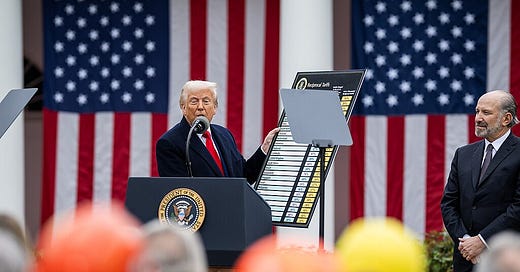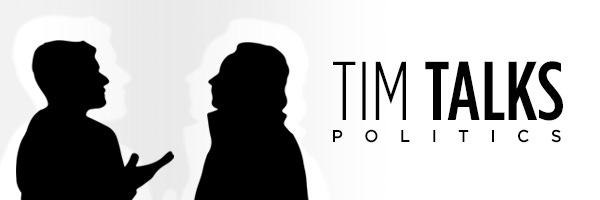April 4: Tariffs, “Liberation Day,” and the remaking of world order
In which, Trump makes good on his “reciprocal tariffs” promise, jailing political opponents seems to be preserving authoritarians and democracies alike, and special elections deliver mixed results.
Tariffs, “Liberation Day,” and the remaking of world order
“Destroying the economy,” “doomed,” “blunder,” “stagflation,” “reckless.”
This was the drumbeat of the American commentariat this week as President Trump unveiled his reciprocal tariffs policy that levied tariffs against most of America’s trading partners.
Truly, we haven’t seen a comprehensive tariff like this since the Great Depression era with the Smoot-Hawley Tariff, and we haven’t seen rates this high since the 19th century, so this is indeed a watershed moment in American trade policy. But will it have the destructive effects that everyone from Democrats to Rand Paul seem to think? Well… like most things, that’s a little more complicated.
Wall Street did react in a predictably poor way to the tariffs, immediately dropping over 1,000 points the day after the announcement, and numerous countries announced they were preparing their own counter tariff packages. And yet… car manufacturers domestic and international announced plans to make new investments in American production capacity, which is exactly the chief objective of the tariffs.
Here, again, we see that “Wall Street”- “Main Street” divide in American economics and politics where the money movers don’t like the unpredictability the tariffs admittedly introduce into the global economy, but American workers can anticipate fresh inflows of investment into domestic production.
Really important to remember that with these tariffs, it’s not just an economic policy problem, but a political and social issue as well. The Trump administration’s basic approach to tariff’s rest on a few key points:
The previous low tariff approach was never a true free trade policy, but a Cold War-era geostrategic policy aimed at rebuilding Western Europe after World War II by giving those countries open access to American markets and financing. That was the Marshall plan.
That basic template worked so well in rebuilding Europe that it developed into a de facto trade policy that essentially allowed smaller countries to protect their markets from American competition while getting the benefits of exporting to American markets.
While the American citizen benefited as a consumer from this approach, that same citizen benefited less as a worker.
So long as America’s national debt was manageable and we could continue to run deficits to prop up this arrangement, then worker concerns could be papered over with generous social welfare programs.
BUT…. it didn’t work out that way. Eventually the inflationary pressures caught up with government and household finances alike producing our current state of affairs of record levels of debt defaults and unsustainable budgets.
In sum, the Trump administration sees reciprocal tariffs as rebalancing America’s trade deficit in order to begin the arduous process of rebalancing the federal government’s books and improving the American worker’s earnings and opportunities… all at the same time.
Critically, the tariff’s aren't supposed to do all this heavy lifting. The Trump economic agenda is built on auditing and cleaning the books, downsizing the government footprint via workforce reduction and deregulation, making permanent the 2017 tax cuts, and these tariffs.
This is about trying to turn the ship of state, however, ponderously, away from the perverse incentives of inflationary monetary policy and government-driven market activity, and back towards a more market-oriented set of economic incentives.
I’ll be the first to admit that I’m skeptical of this broad based tariff approach, but I’ll also admit that 1) I do think the status quo in trade has not been good for average Americans, especially those under the age of 50, and 2) that status quo is so entrenched in our policy and government structures that only a top down rethink is going to meaningfully change things in a more favorable direction. So, despite my skepticism, I’m at least willing to take a “wait and see” approach on this, especially given the comprehensive nature of Trump’s economic rebuilding attempt.
So, key takeaways for you, dear reader:
This is a massive economic retooling/course correction, so you should anticipate short term pain in terms of market losses and/or micro recessions in certain economic sectors. Will it lead to a destructive recession? That’s unclear.
The tariffs are not a policy in isolation, but are designed to work in conjunction with other policy changes, so keep an eye on those.
Given that the historical examples being trotted out to condemn these tariffs are few (Smoot-Hawley being the most cited), be careful of reading too much into these. They’re not as predictable as many claim.
These tariffs are not introducing tariffs where none existed prior. There’s a myth being bandied about that these tariffs are destroying a free trade regime that underpinned the liberal international order. That is false. As noted above, it was free trade of a sort, but it was a free trade for countries exporting to the US, it was never free trade for American exports.
Level heads and steady eyes, friends. This is a significant development in world economics and politics, but it doesn’t automatically herald a global catastrophe like some are suggesting. That can become a self-fulfilling prophecy, however, if pundits and policymakers alike stay in their analytical and ideological silos.
PS: A quick note on Russia allegedly ducking the tariffs: Trump has already threatened Putin with tariffs, so I suspect leaving Moscow off this initial list due to the fact that America’s trade deficit with Russia is paltry, and Trump is reserving tariffs for leverage in ceasefire negotiations on Ukraine.
Keep reading with a 7-day free trial
Subscribe to Tim Talks Politics to keep reading this post and get 7 days of free access to the full post archives.





